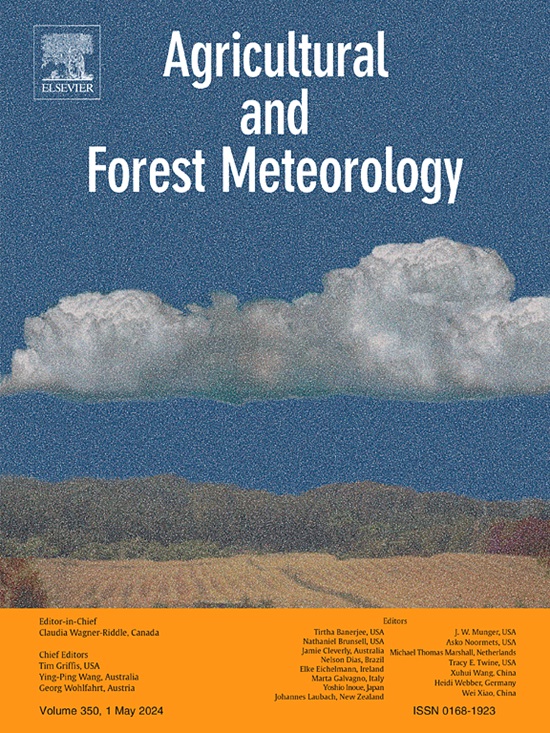Characterizing the vertical variability of canopy structure from space: Implications for biodiversity, productivity, and ecosystem functioning
IF 5.6
1区 农林科学
Q1 AGRONOMY
引用次数: 0
Abstract
The vertical variability of canopy structure plays a crucial role in regulating turbulent flux exchange, biodiversity, and ecosystem functioning. However, accurately measuring this variability over large areas is challenging. We utilize the Global Ecosystem Dynamics Investigation (GEDI) data to characterize the spatio-temporal variability of canopy structure across India’s diverse forest ecosystems for the first time. The GEDI-derived canopy metrics exhibited right-skewness, bimodality, and left-skewness influenced by growth patterns, seasonality, human activities, and climate. The Plant Area Volume Density (PAVD) data from GEDI was used to fit the shape parameters of the beta distribution function, effectively estimating the vertical variability of canopy structure using minimal data. The results show that the beta distribution function shape parameters accurately captured the vertical variability of canopy structure across different biomes ( = 0.76 to 0.87, RMSE= 0.1 to 0.2). Clustering the beta distribution parameters identified six distinct foliage profiles in India, which affected radiation interception both diurnally and seasonally at various canopy heights. Further, multivariate functional diversity indices, such as functional richness and functional divergence, captured the combined effects of canopy structural attributes including canopy height, density, complexity, and vertical heterogeneity on biodiversity and productivity. A significant correlation (r = 0.35–0.668, p 0.05) was observed between these improved functional diversity metrics and above-ground biomass density across India’s forested regions. Additionally, we found that these functional diversity metrics are influenced by various environmental factors like climate, soil, and topography, which differ across forested regions. These findings enhance our understanding of the complex relationships between canopy structure, the environment, and productivity across India’s biomes and forest ecosystems from spaceborne observations.
从空间表征冠层结构的垂直变异:对生物多样性、生产力和生态系统功能的影响
冠层结构的垂直变异在调节湍流通量交换、生物多样性和生态系统功能方面起着至关重要的作用。然而,在大范围内准确测量这种变化是具有挑战性的。利用全球生态系统动力学调查(GEDI)数据,首次对印度不同森林生态系统的冠层结构进行了时空变化特征分析。gedi衍生的冠层指标受生长模式、季节、人类活动和气候的影响表现为右偏、双峰和左偏。利用GEDI的植物面积体积密度(PAVD)数据拟合beta分布函数的形状参数,利用最小数据有效地估计了冠层结构的垂直变异。结果表明,β分布函数形状参数能较准确地反映不同生物群系冠层结构的垂直变异(R2 = 0.76 ~ 0.87, RMSE= 0.1 ~ 0.2)。通过对beta分布参数的聚类,确定了印度6种不同的叶片剖面,它们对不同冠层高度的日和季节辐射拦截都有影响。功能丰富度和功能分化度等多元功能多样性指数反映了冠层高度、密度、复杂性和垂直异质性等冠层结构属性对生物多样性和生产力的综合影响。改善后的功能多样性指标与印度林区地上生物量密度呈显著相关(r = 0.35 ~ 0.668, p≤0.05)。此外,我们发现这些功能多样性指标受到气候、土壤和地形等各种环境因素的影响,这些因素在不同的森林地区有所不同。这些发现增强了我们对印度生物群落和森林生态系统的树冠结构、环境和生产力之间复杂关系的理解。
本文章由计算机程序翻译,如有差异,请以英文原文为准。
求助全文
约1分钟内获得全文
求助全文
来源期刊
CiteScore
10.30
自引率
9.70%
发文量
415
审稿时长
69 days
期刊介绍:
Agricultural and Forest Meteorology is an international journal for the publication of original articles and reviews on the inter-relationship between meteorology, agriculture, forestry, and natural ecosystems. Emphasis is on basic and applied scientific research relevant to practical problems in the field of plant and soil sciences, ecology and biogeochemistry as affected by weather as well as climate variability and change. Theoretical models should be tested against experimental data. Articles must appeal to an international audience. Special issues devoted to single topics are also published.
Typical topics include canopy micrometeorology (e.g. canopy radiation transfer, turbulence near the ground, evapotranspiration, energy balance, fluxes of trace gases), micrometeorological instrumentation (e.g., sensors for trace gases, flux measurement instruments, radiation measurement techniques), aerobiology (e.g. the dispersion of pollen, spores, insects and pesticides), biometeorology (e.g. the effect of weather and climate on plant distribution, crop yield, water-use efficiency, and plant phenology), forest-fire/weather interactions, and feedbacks from vegetation to weather and the climate system.

 求助内容:
求助内容: 应助结果提醒方式:
应助结果提醒方式:


